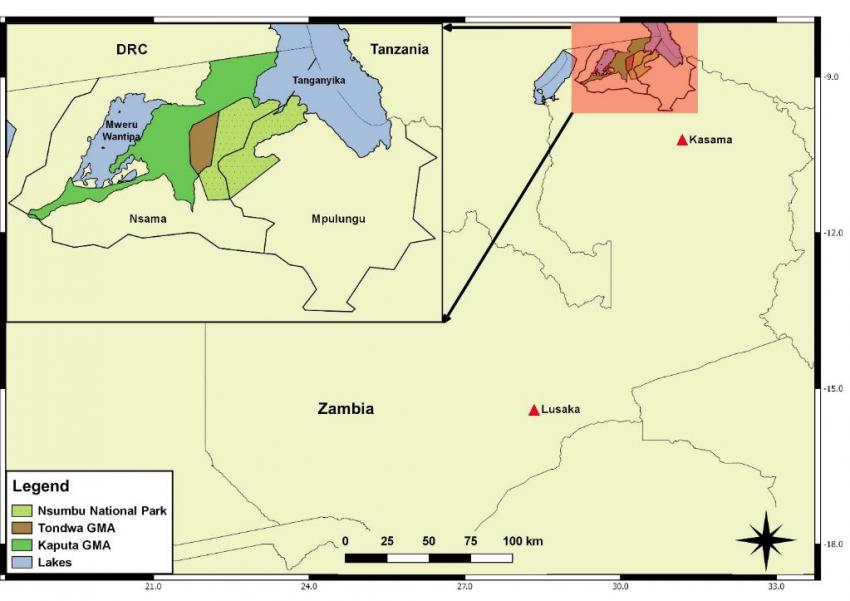Zambia endorses its first ever climate change framework and action plan for a protected area
Nsumbu National Park is located across the districts of Mpulungu and Nsama in Zambia’s Northern Province and falls within the biodiverse Albertine Rift region of East-Central Africa, covering an area of approximately 2,020 km². Nsumbu NP hosts patches of rare and endangered Itigi-Sumbu thicket, and flagship species in the park include the African elephant (Loxodonta africana), Blue Duiker (Philantomba monticola), Sitatunga (Tragelaphus spekii), Puku and Hippopotamus (Hippopotamus amphibius).
Nsumbu was declared a National Park on 25 February 1972, and was established to manage and conserve, inter alia, the area’s various land types, terrestrial and freshwater ecosystems, endemic and endangered Itigi-Sumbu thicket, biodiversity, and historic and cultural sites for economic, recreational and scientific purposes. The Park is under the Department of National Parks and Wildlife (DNPW), under the Ministry of Tourism and Arts, and is responsible for the park’s governance and management. Nsumbu NP management is headed by a Senior Ranger under the supervision of the Kaputa-based Wildlife Warden. The area under the management’s jurisdiction includes the park itself, as well as Tondwa and Kaputa Game Management Areas (GMA).
Challenges
Nsumbu National Park, as many protected areas in Africa, is facing serious threats including poaching, overfishing, frequent and uncontrolled wildfires, invasive alien species, inadequate demarcation of park boundaries, and limited financial, human and institutional capacities. In addition, human settlement and agricultural encroachment, deforestation, inadequate waste management, land and soil degradation, erosion, and a proposed construction of an airport in the ecologically sensitive Kasaba Bay area add to the already fragile state of the National Park.
Climate change is increasingly being recognised as a major threat that will not only present new risks and threats to protected areas but will also exacerbate existing threats and vulnerabilities. Shifting rainfall and temperature regimes are expected to cause an increase in the frequency and intensity of extreme weather events, soil erosion and consequently the sedimentation of freshwater systems, the frequency and intensity of water shortages, potential evapotranspiration, the frequency and intensity of fires, and lake surface temperatures.
The Integrated Planning Project is working to support the integration of climate change and biodiversity concerns into spatial planning frameworks including protected areas management planning. It works in four districts of Lake Tanganyika: Mpanda (subsequently renamed Tanganyika) and Nkasi Districts in Tanzania; and Nsama and Mpulungu Districts in Zambia.
The meeting
To strengthen the adaptive capacity and climate resilience of Nsumbu NP and its surroundings, IUCN and the Department of National Parks and Wildlife (DNPW)[1] have developed a Climate Change Framework Strategy and Action Plan. The strategy will serve as a tool for integrating climate change issues into Nsumbu National Park planning processes.
On 5 December 2017, representatives from Ministries, Departments and Agencies and NGOs convened in Lusaka, Zambia, for a national meeting. The meeting was chaired by Mr Paul Zyambo, Director General for the DNPW, on behalf of the Permanent Secretary of the Ministry of Tourism and Arts. He was flanked by Leo Niskanen, Technical Coordinator of the Conservation Areas and Species Diversity Programme at IUCN's Eastern and Southern Africa Regional Office.
The meeting was organised by the Ministry of Tourism and Arts, with technical and financial support from the Integrated Planning to Implement the CBD Strategic Plan and Increase Ecosystem Resilience to Climate Change Project, a global project being implemented by IUCN’s Environmental Law Center as well as IUCN’s Global Protected Area Programme and three IUCN Regional Offices. The project is funded by the German Federal Ministry for the Environment, Nature Conservation and Nuclear Safety (BMUB).
The aim of the national meeting was to validate the Nsumbu National Park Climate Change Framework Strategy, whose goal is to strengthen the climate-resilience of the Park, surrounding Game Management Areas and the local communities who are dependent on the landscape and its natural resources for their livelihoods.
From planning to action
Following fruitful discussions amongst stakeholders, the Climate Change Framework Strategy and Action Plan for Nsumbu National Park was endorsed. It was agreed that the climate change strategy and action plan, or sections of it, will be implemented as part of the park’s updated General Management Plan (GMP) as part of the 2015 Zambia Wildlife Act. The review of the GMP is expected to start in early 2018 with financial support from Lake Tanganyika Development Project. The Integrated Planning Project will provide appropriate technical support and engage in the review progress.
The Guest of Honour Mr Zyambo noted that the strategy was “an important milestone for protected areas management in Zambia, the first of its kind, and theDNPW) are planning to roll it out in other National Parks in the country. We are keen to document lessons from Nsumbu National Park to inform future similar initiatives in other protected areas”.
Ms Dora Kamweneshe, the Coordinator for the Lake Tanganyika Development Project added: “This is an exciting milestone for us to have a localised action plan that will guide our climate change activities in Nsumbu National Park and neighbouring Game Management Areas”. The representative from the Ministry of Water Development, Sanitation and Environmental Protection, Ms Kanyata Mayando, said they were “thrilled to take a lead in having a first ever area based strategy for addressing climate change”.
The National Meeting marks the end of the strategy development processes started in August, 2017. The development of the strategy was led by Kevin Emslie from C4 EcoSolutions.
[1] formerly known as the Zambia Wildlife Authority (ZAWA)
 Photo: DNPW
Photo: DNPW
For more information, you can visit the Integrated Planning for Climate Change and Biodiversity project page, or contact Doyi Mazenzele.







